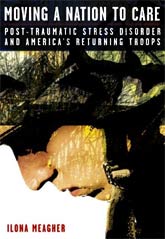LinkBlog
Crying Shame - a Priory Group survey about stigma and mental illness in Britain (pdf)
6 Golden Rules for Conquering Performance Anxiety by David Leisner
Freedom from Fear's On Target Summer/Fall 2007 newsletter - an anxiety & depression resource (PDF)
Switching between monoamine oxidase inhibitors (MAOIs) and SSRI or tricyclic antidepressants (.doc format)
Quick scan of brain's magnetic fields could diagnose brain diseases

Until recently physicians have had to rely on time-consuming and uncertain behavioral examinations to diagnose the onset of brain diseases such as multiple sclerosis, Alzheimer's and schizophrenia.
Now researchers from the University of Minnesota Medical School and Brain Sciences Center at the Minneapolis VA Medical Center led by Professor Apostolos P. Georgopoulos have identified a non invasive and painless way to diagnose complex brain diseases using magnetoencephalography (MEG) to record tiny magnetic fields in the brain. And it's as simple as staring at a point of light.
Professor Georgopoulos and his team were inspired to try MEG scanning as a diagnostic tool after discovering that neural interactions across human subjects were very similar. The team published their initial work on this novel way of assessing the dynamic interactions of brain networks acting in synchrony in a 2006 issue of the Proceedings of the National Academy of Sciences.
The use of MEG scans could be a boon for neurologists and psychiatrists as it may provide a fast and simple screening test for brain diseases, while also helping differentiate between different brain diseases that have similar symptoms.
All behavior and cognition in the brain involves networks of nerves continuously interacting on a millisecond by millisecond basis. MEG scanners have sensors that can record these interactions just as quickly, much faster than current methods of evaluation such as the functional magnetic resonance imaging (fMRI), which takes seconds to record. The measurements recorded represent the workings of tens of thousands of brain cells. Each scan takes between 45-60 seconds.
The brains of 142 volunteers, including people with Alzheimer's disease, chronic alcoholism, schizophrenia, multiple sclerosis or Sjogren's syndrome, plus those of healthy controls were scanned for the study. The team first studied 52 volunteers to find patterns of neural activity that could identify all the different illnesses.

By comparing the patterns of tiny magnetic charges in healthy brains to those afflicted with diseases such as Alzheimer's, the team has been able to identify the patterns commonly associated with these debilitating diseases.
"This elegantly simple test allows us to glimpse into the brain as it is working," Georgopoulos said. "We were able to classify, with 100 percent accuracy, the various disease groups represented in the group of research subjects."
They then tested a further 46 patients to see whether the patterns found from the first group could accurately diagnose disease within a second group. Here, many of the predictors found from the first set of participants also correctly diagnosed more than 90% of subjects in the second sample.
Professor Georgopoulos said, "We want to continue and acquire data from a large number of subjects - patients and matched controls. The throughput of this MEG test is large so we can continue a high rate of testing and we hope that clinical applications can become a reality in a year or two."
Diagnosing brain illnesses has always been very difficult, particularly in the early stages. Physicians are forced to rely on conversations with patients, memory tests, physical examinations and, occasionally, brain scans. It is sometimes not until post-mortem or after a biopsy that a cause of illness can be confirmed.
"This discovery gives scientists and physicians another tool to assess people's disease progression," Professor Georgopoulas explained. "In the future it could be applied when studying the effect of new treatments or drug therapies."
The team will continue to collect more data on the six disease groups studied to date, and plan to start analyzing research subjects with other brain diseases, including depression, post-traumatic stress disorder, autism, and Parkinson's disease, to see if the same technique can be applied.
The research is supported by the Department of Veterans Affairs, American Legion Brain Sciences Chair and grants from the Academic Health Center, University of Minnesota; Minnesota Medical Foundation; University of Minnesota Graduate School; Department of Veterans Affairs Clinical Science Research Division; National Institute of Mental Health; and the National Institutes of Health.
Georgopoulos AP, Karageorgiou E, Leuthold AC, Lewis SM, et al. Synchronous neural interactions assessed by magnetoencephalography: a functional biomarker for brain disorders J Neural Eng 2007 Aug;4:349-355[Abstract | Full text (Free registration req'd)]















